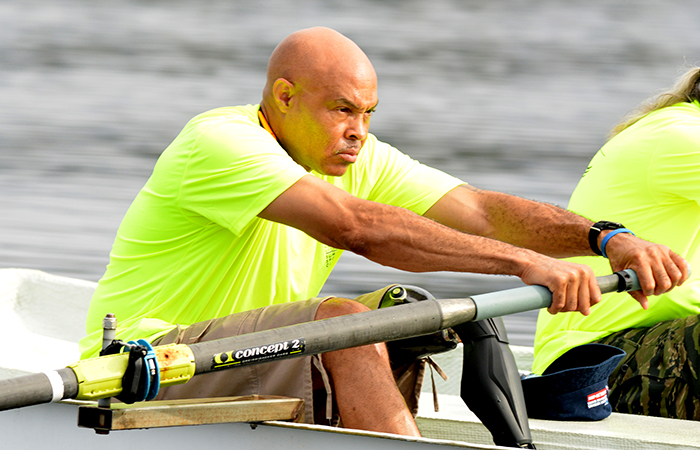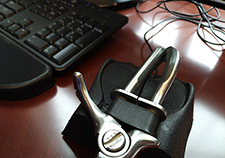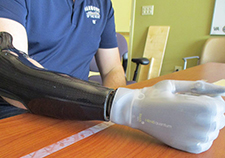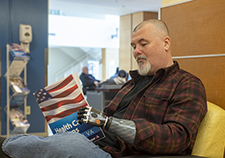Office of Research & Development |
 |


A Veteran who uses a lower-limb prosthesis takes part in the 2016 National Veterans Summer Sports Clinic. (VA photo)
September 26, 2019
By Mike Richman
VA Research Communications
"The pain can lead to opioid addiction, disability, divorce, or suicide. All of these possibilities are very concerning. We want to help Veterans avoid them..."
Researchers at the Hunter Holmes McGuire VA Medical Center in Richmond, Virginia, are testing whether nerve stimulation can help Veterans with post-amputation pain. A small pilot study involving 16 Veterans is now underway.
Limb loss is often associated with post-amputation pain that can be challenging to treat and may require the use of opioids, painkilling drugs that can become addictive.
The discomfort could be in the form of acute pain, which is sudden and typically lasts for up to three months post-surgery, or chronic pain, which can persist for six months or more.
Advances in neuromodulation—which involves implantable and non-implantable technologies that impact the transfer of information such as pain signals through the nervous system—have led to the development of a peripheral nerve stimulation system (PNS) that has shown promising results for chronic post-amputation pain. Studies involving the minimally invasive Sprint PNS system have found that it reduced residual (stump) pain, which is at or just above the incision site, and phantom pain, which is pain that originates in the brain and spinal cord and feels like it’s from a limb that was removed.
In peripheral nerve stimulation, a form of neuromodulation, electrodes are placed along peripheral nerves, which are located beyond the brain or spinal cord, to control pain. An electrical current sent to the nerves tricks the brain into turning off or reducing painful signals.
What about the acute post-amputation period? Dr. Denise Lester, an anesthesiologist at the Richmond VA, is exploring that question. She’s leading a pilot study on the feasibility and effects of the Sprint PNS system in the acute pain period following amputation. It’s the first study of its kind, she says.

VA engineering research center posts another invention: prosthetic hook mouse

VA scientists testing new technology to absorb moisture, increase comfort with prostheses

Study probes user satisfaction with upper-limb prostheses
The U.S. Food and Drug Administration (FDA) has approved the Sprint PNS device for treating acute and chronic pain.
“Currently, there’s no convincing evidence regarding the role of PNS in the acute post-amputation period,” says Lester, who’s also an assistant professor at Virginia Commonwealth University. “That may be a critical time to control pain, as those with high pain appear to be at greater risk of developing persistent post-procedural pain.”
A prosthesis can possibly be fitted faster on patients with little or no pain—maybe about two months after amputation if all goes well, she notes.
“Yes, definitely,” she says. “Earlier and better and worn more often, more and more hours a day. One of the biggest barriers to prosthesis fitting and use is pain.”
“The problem is many of these patients can’t get pain control,” Lester adds. “So you’re looking at the possibility that the pain can lead to opioid addiction, disability, divorce, or suicide. All of these possibilities are very concerning. We want to help Veterans avoid them within our community.”
Lester is pursuing her pilot study knowing that post-amputation pain lacks what she calls a “non-opioid, non-local anesthetic, non-destructive option.” The latter refers to the possibility of damaging nerves, for instance, by treating the pain with heat, ice, or burning chemicals. She also understands that prior to the FDA’s approval of Sprint PNS for acute pain, patients would be discharged from the hospital with nothing but opioids or a local anesthetic catheter, which brings the risk of infection.
She explains that the Sprint PNS technology can thus be a “bridge” between hospital pain control methods and the home. “That means patients would get amputated in the hospital with excellent pain care,” she says. “They would feel great but would go home with just opioids. They’d be in severe pain for up to months until the surgical site heals or for years and years later. There’d be no bridge in pain management between the acute post-surgical time and the period long after surgery. So this 60-day device can be a bridge between great hospital care and pain control needs that occur later on.”
Lester was also curious to see if the Sprint PNS device, when applied at the time of amputation, would lead to earlier fitting of the prosthesis. She wanted to learn, too, if it would help with wound healing, minimize the potential for pain in the transition from acute to chronic stages, and decrease other possible post-operative problems of pain management, such as opioid addiction and catheter infection.
The Sprint PNS system, made by Ohio-based SPR Therapeutics, is the only PNS device administered through the skin that is FDA-cleared for chronic and acute pain and doesn’t have to stay in past 60 days. In minimally invasive surgery, a three-inch wire lead that looks like a piece of dental floss is placed through the skin using ultrasound guidance to target an area close to the femoral nerve or the sciatic nerve, depending on where the patient is feeling pain. Double leads are inserted if both nerves are causing pain.
A matchbox-size stimulator is then placed on the patient’s back, hand, or foot to deliver mild electrical pulses to the targeted nerve for up to 60 days. The pulses are meant to cause a comfortable sensation over an area supplied by that nerve. The goal is to have continued pain relief for at least one year.
The patient can control the stimulation by turning the PNS device on and off and can adjust the stimulation parameters as needed. The device is removed after 60 days, at which point the risk of infection is “minimal,” Lester says. Other PNS systems are implantable for life, but “this is the only one I’m aware of where you use the device for 60 days and take it out to get long-term relief,” she says. She notes that she has no commercial ties to SPR Therapeutics.
Thus far, two studies have analyzed the ability of the Sprint PNS device to ease post-amputation chronic pain. One of them, a 2014 home trial, found that the technology reduced stump pain and phantom limb pain and made it easier for patients to brush their teeth, comb their hair, and get dressed, among other daily activities. A 2019 study found that the device was much more effective than placebo in easing stump pain and phantom limb pain.
Lester’s pilot study includes 16 Veterans who have undergone non-traumatic lower-limb amputation above the knee (transfemoral) or below the knee (transtibial). The amputations were needed because of such conditions as critical limb ischemia, a severe blockage in the arteries of the lower extremities that reduces blood flow; Charcot joint disease, a progressive degeneration of a weight-bearing joint; or gangrene, which occurs when tissue dies due to a loss of blood supply.
The participants have been randomized evenly, with patients in the treatment group undergoing placement of the Sprint PNS system within seven days of surgery. Patients in both groups are eligible to be treated with opioids and non-pharmacologic pain therapies, such as acupuncture, ice, heat, a massage, mindfulness, or meditation. They are evaluated weekly for the first eight weeks post-amputation, then at three, six and 12 months.
Lester and her team have collected three months of data thus far, with evaluations of the average percent reductions in stump pain and phantom pain at the 60-day mark. She says the results have been “very encouraging.” The Sprint PNS device has helped reduce both stump and phantom pain in the treatment group, with the difference in average pain relief between both cohorts being the largest for phantom pain.
The researchers offered the same type of medical therapy to both groups because they wanted to see if the treatment group would need narcotics to quell their pain. Thus far, none of the eight patients who used the PNS Sprint device have requested opioids, according to Lester. “The treatment patients have the option to get opioids, but they don’t need them because they’re getting relief,” she says.
Pain levels are still being periodically assessed. The study team will have evaluated all of the participants for one year by March 2020.
Lester notes that she and her colleagues would be “testing a different thesis” if they were just focusing on patients with chronic pain who are using the Sprint PNS device.
“Chronic pain patients usually have a lot of overlay, like depression and disability and other things that can make good pain scores less achievable,” she says. “Those patients often have a lot of comorbid situations going on, behaviorally or socially or even with diseases.”
She further explains that certain issues come into play in post-amputation research that can’t be studied in a chronic pain trial. They include
A goal of the pilot study is to weigh the feasibility of pursuing a multi-site, randomized controlled study. Lester is considering its main goals and size, both of which will be determined, in part, by an analysis of the pilot study. She and her colleagues want to know what hospitals are willing to participate, what equipment they need to have in place, how much research support they have, and whether they have an ultrasound suite. The researchers have so far contacted VA sites with large amputation centers to gauge their interest in participating, including hospitals in the Bronx, New York; Palo Alto, California; and Tampa, Florida.
“Our biostatisticians have been trying to figure out how best to power the study,” Lester says. “To do that, it may be best to get 12 months of data from the pilot study. That way, we can determine if there’s a change in effect that’s very, very large. So if everybody came in with 10 out of 10 pain, and 100 percent of the patients with the device went to zero and 100 percent of the patients without the device stayed at 10, then the effect size is really, really, really good. It’s almost too good to be true. Once we figure out that number and decide whether it’s a four-year study with an enrollment of 20 patients a month, or something like that, we can decide which hospitals can achieve those numbers.”
“Before we can say cause and effect in reference to the Sprint PNS, we need a large-scale, multi-site study,” she adds. “I hope we’re able to begin that soon.”
Cassandra Peterson was left with only one option: amputation.
The Air Force Veteran had undergone a half-dozen surgeries over a five-year period to relieve the discomfort in her left foot, where she had a series of problems. A rheumatoid tumor led to the dislocation of four joints. She also had Charcot joint disease, which degenerates weight-bearing joints, and cellulitis, an inflammation of connective tissue below the skin.
Her foot never healed properly from the operations, and doctors advised her to pursue amputation. At the same time, she volunteered for Dr. Denise Lester’s pilot study on peripheral nerve stimulation at the Richmond VA (see main story). Doctors removed Peterson’s leg below the left knee in November 2017.
A few days later, Peterson began using the Sprint PNS device that is the centerpiece of Lester’s study and kept it on for 60 days. She says it “took time” for her residual and phantom pain to dissipate. But today, nearly two years after the amputation, she’s experiencing about a 90% decline in both types of pain mostly because of the Sprint PNS.
“Probably the best thing I could have done in the world was to have my bad leg removed,” Peterson says. “To get into this research study and to be able to hardly have any pain … this is awesome.”
Peterson’s account is anecdotal and may not be typical of other Veterans in the study. Lester hopes to gain more evidence over time.
Peterson was the first Veteran among the eight patients in Lester’s treatment group to undergo amputation. She says she initially felt phantom itching around her left ankle and phantom pain below the incision site, as well as pain in the residual limb, before the Sprint PNS was positioned near her left knee. She felt pain in both the femoral nerve and sciatic nerve, so double leads were inserted into the Sprint PNS to provide electrical currents to both nerves.
During the 60-day period, she rubbed the end of her residual limb every day. “You do that so your brain resets itself so it understands that’s where your nerve endings are,” she says. “That helps your body not have so much phantom pain or phantom things like itching.”
She notes that the Sprint PNS has three levels of stimulation, and that she tried to keep it on medium. “The goal is having the stimulator as high as you can tolerate because if you can do that, ideally you’ll have less pain when you take it out,” she says. “I kept it on medium for a couple of weeks with no problem, but sometimes when I had pain we’d have to reset it to a lower point. Then you’d just have to work yourself back up. This process went on for the entire 60 days. During that time, I couldn’t tell if it was making a difference or not. However, afterward I could tell it made a difference because I didn’t have as much phantom sensation or phantom itching.
Although she’s feeling much better overall, Peterson still experiences day-long periods of phantom pain.
“When I have phantom pain now, it’s relentless,” she adds. “It’s in the same spot, and it lasts for about a 24-hour period, and I’m okay with that. There’s no pattern to it. I’m really into patterns and trying to see if one thing is related to the next. But it’s strange. It’s always in the same spot, and it always lasts for a long period of time. That’s 24 hours for me consistently.”
While wearing the Sprint PNS, Peterson took the narcotic oxycodone (commercial name Oxycontin) to help ease her pain. She still takes the drug.
For users of the Sprint PNS, Lester and her colleagues believe a prosthesis can possibly be fitted on a patient with little or no pain about two months after amputation. Peterson was fitted with her prosthesis three months after her surgery.
Peterson, who is a nurse, will probably never be what she calls “100% pain-free” because she has rheumatoid arthritis, in addition to lingering pain from the amputation. Rheumatoid arthritis is a chronic inflammatory disorder that can affect joints, skin, eyes, lungs, heart, and blood vessels.
She says her experience as a nurse has helped her appreciate the pain relief she’s experienced through nerve stimulation.
“I can compare myself to actual patients that I’ve taken care of, so I can tell the difference,” she says. “I experienced the difference. People who haven’t had the opportunity to have the stimulator always complain about pain or some other type of sensation. I’m past that point.”
--- Mike Richman
VA Research Currents archives || Sign up for VA Research updates